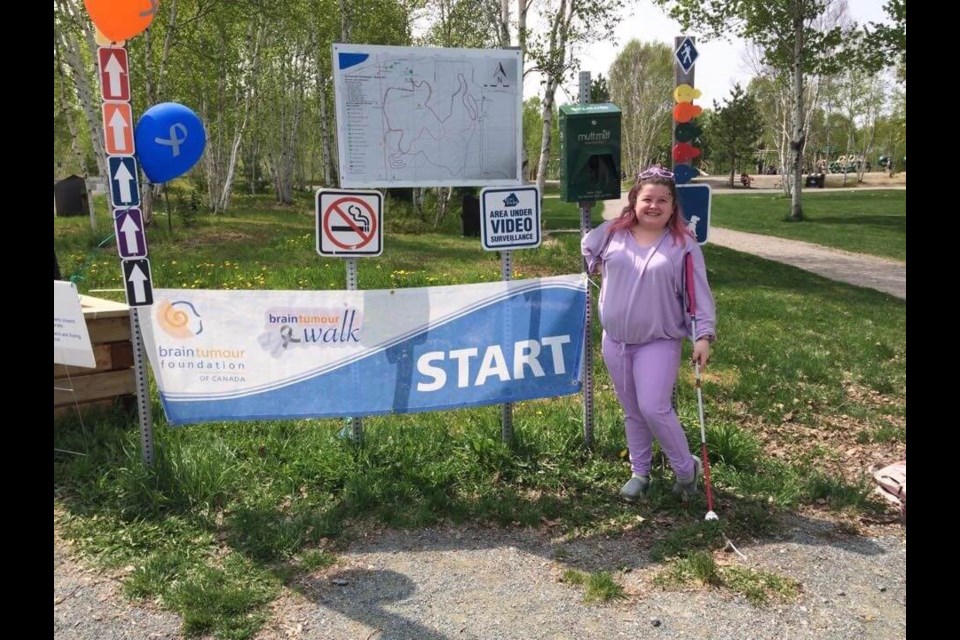It’s hard to capture an infectious giggle in words, but that’s exactly what you get when you speak to Alicia Chenier.
After attending her very first Brain Tumour Walk event in 2019, Chenier is back – this time as Brain Tumour Foundation of Canada’s Sudbury walk ambassador for the 2020 Virtual Brain Tumour Walk, the organization said in a news release this week.
The virtual event happens June 27 and kicks off at noon as Canadian broadcaster Alan Cross, a writer on music, gets the event going. Participants will share their "steps" using #VirtualBrainTumourWalk. Steps can be anything you like; jumping, dancing, walking your dog, or just a stroll in your backyard! Post your activity and use #VirtualBrainTumourWalk to make sure we see you!
For Chenier, living with a brain tumour has been a lifelong endeavor. At just six months old, she was diagnosed with Craniopharyngioma – a childhood tumour found in the pituitary area of the brain. She has undergone three brain surgeries — the first at only eight months old — experienced loss of vision, and complications from multiple medications.
Yet, she laughs every day and is determined to inspire people by sharing her experience.
“To most people, being called a survivor is a huge compliment,” Chenier said in the news release. “But for me, living with a brain tumour is my normal.”
Chenier’s journey began when her mom became concerned with her baby’s unexplained condition. She was “a very sick baby who was always thirsty and had a weird shaped head,” in Chenier’s words. Her mom also noticed she couldn’t see from one eye.
Multiple doctor’s visits later, Chenier received an MRI. Later that same day, they were flown by helicopter from their home in Sudbury to SickKids in Toronto. At eight months old, she had her first brain surgery, where she received her diagnosis.
When she was just a toddler, another surgery resecting the tumour produced a scar that stretched from ear to ear. It was only when Chenier had her third brain surgery at age 15, that she really understood the intensity of such a surgery.
A keen student, she had arranged for the surgery to take place during March break. She went back to school on the Tuesday after March break and had a literary test the next day.
“I didn’t pass,” she said with a laugh. “I was only off by a couple points, so I begged for leniency. They wondered why I was back to school so fast. Looking back, I should have taken a longer break to recover.”
This surgery helped relieve the daily headaches Chenier suffered, an outcome that was hoped for, but not guaranteed. However, the relief came with some serious side effects.
The vision in her left eye was now completely gone, leaving her with tunnel vision in her right eye. The tumour also caused damage to her pituitary gland, causing many hormonal issues. As a result, doctors had to remove her pituitary gland.
“I had to take nightly injections for growth hormone deficiency,” Chenier said. “I have to closely watch my fluid intake because of Diabetes Insipidus. When I get sick, it is a struggle because of adrenal insufficiencies. Since I don’t have a pituitary gland, I now take many medications to replace the hormones it used to make.”
She still has yearly checkups with her doctors. Since her last surgery, she has had no tumour growth.
Despite the lasting effects of her combined surgeries, having a brain tumour has also had a positive impact on Chenier’s life. She said her particular circumstances have made her cherish and appreciate things all the more, adding she has also helped motivate people – intentionally or not.
“They think I’m inspirational,” she said. “But this is just my daily life.”
Chenier also attends the local brain tumour support group. She said it’s nice to be able to connect with others.
“It’s helped me a lot,” she said. “I call it my monthly therapy time.”
Her advice to everyone – brain tumour or not – is laughing every day.
“Find the funny. Find the bright side,” she said. “My brain tumour may have taken part of my vision, but it will never take away my passion to make change in this world.”
Chenier is now in college studying to be an early childhood educator, and has maintained a 4.0 average, as well as making the Dean’s List. She said she wants to advocate for children with special needs, especially those with visual impairments.
And all this is happening to someone who was told they wouldn’t graduate high school.
You can follow Chenier's Instagram here.
To register for the 2020 Virtual Brain Tumour Walk, visit www.braintumourwalk.ca. Chenier’s story and others can be found at www.braintumour.ca.
Quick facts:
- Each day in Canada, 27 people will hear the words, “You have a brain tumour.”
- There are an estimated 55,000 Canadians currently living with a brain tumour.
- Signs and symptoms can include headaches, dizziness, blurred vision and behavioural changes, in addition to morning nausea, hearing impairment and weakness or paralysis.
- There are more than 120 different types of brain tumours, making effective treatment very complicated.
